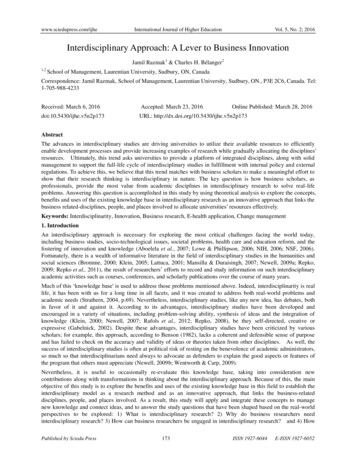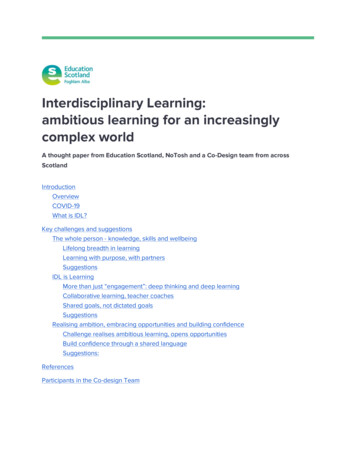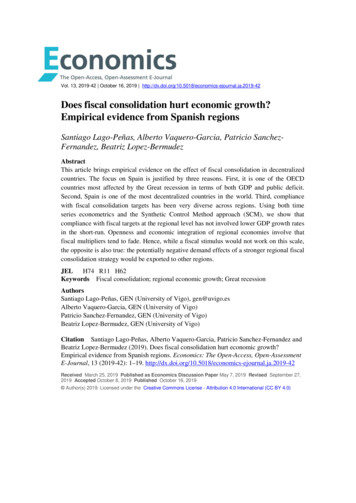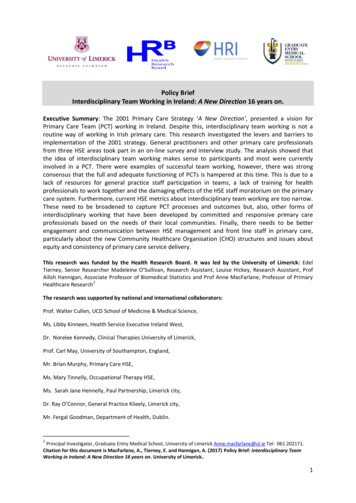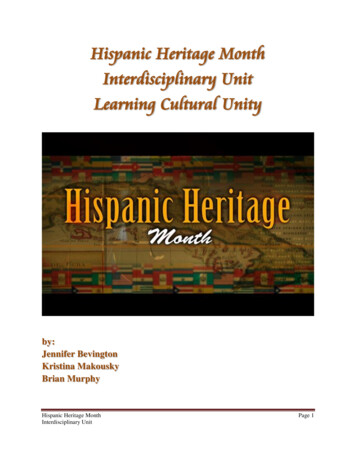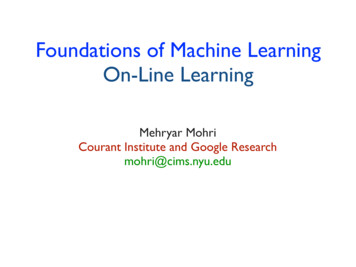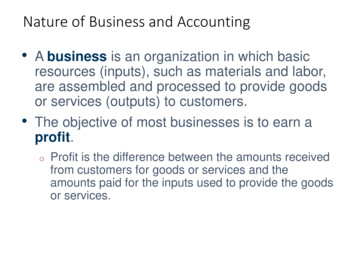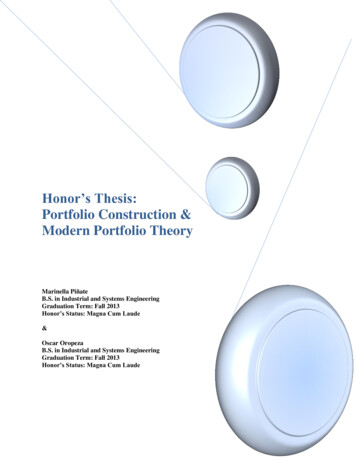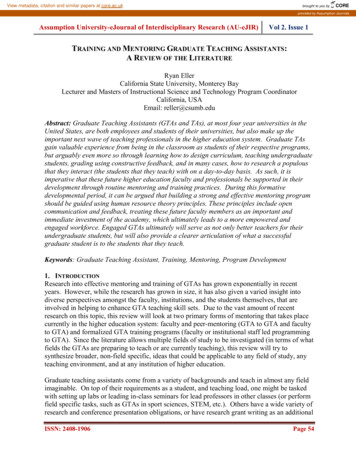
Transcription
View metadata, citation and similar papers at core.ac.ukbrought to you byCOREprovided by Assumption JournalsAssumption University-eJournal of Interdisciplinary Research (AU-eJIR)Vol 2. Issue 1TRAINING AND MENTORING GRADUATE TEACHING ASSISTANTS:A REVIEW OF THE LITERATURERyan EllerCalifornia State University, Monterey BayLecturer and Masters of Instructional Science and Technology Program CoordinatorCalifornia, USAEmail: reller@csumb.eduAbstract: Graduate Teaching Assistants (GTAs and TAs), at most four year universities in theUnited States, are both employees and students of their universities, but also make up theimportant next wave of teaching professionals in the higher education system. Graduate TAsgain valuable experience from being in the classroom as students of their respective programs,but arguably even more so through learning how to design curriculum, teaching undergraduatestudents, grading using constructive feedback, and in many cases, how to research a populousthat they interact (the students that they teach) with on a day-to-day basis. As such, it isimperative that these future higher education faculty and professionals be supported in theirdevelopment through routine mentoring and training practices. During this formativedevelopmental period, it can be argued that building a strong and effective mentoring programshould be guided using human resource theory principles. These principles include opencommunication and feedback, treating these future faculty members as an important andimmediate investment of the academy, which ultimately leads to a more empowered andengaged workforce. Engaged GTAs ultimately will serve as not only better teachers for theirundergraduate students, but will also provide a clearer articulation of what a successfulgraduate student is to the students that they teach.Keywords: Graduate Teaching Assistant, Training, Mentoring, Program Development1. INTRODUCTIONResearch into effective mentoring and training of GTAs has grown exponentially in recentyears. However, while the research has grown in size, it has also given a varied insight intodiverse perspectives amongst the faculty, institutions, and the students themselves, that areinvolved in helping to enhance GTA teaching skill sets. Due to the vast amount of recentresearch on this topic, this review will look at two primary forms of mentoring that takes placecurrently in the higher education system: faculty and peer-mentoring (GTA to GTA and facultyto GTA) and formalized GTA training programs (faculty or institutional staff led programmingto GTA). Since the literature allows multiple fields of study to be investigated (in terms of whatfields the GTAs are preparing to teach or are currently teaching), this review will try tosynthesize broader, non-field specific, ideas that could be applicable to any field of study, anyteaching environment, and at any institution of higher education.Graduate teaching assistants come from a variety of backgrounds and teach in almost any fieldimaginable. On top of their requirements as a student, and teaching load, one might be taskedwith setting up labs or leading in-class seminars for lead professors in other classes (or performfield specific tasks, such as GTAs in sport sciences, STEM, etc.). Others have a wide variety ofresearch and conference presentation obligations, or have research grant writing as an additionalISSN: 2408-1906Page 54
Assumption University-eJournal of Interdisciplinary Research (AU-eJIR)Vol 2. Issue 1task. In many cases, these students are performing the above work for two primary reasons.Firstly, for many students, this work is how they are paying for their Masters or Doctoraldegree, alongside their housing and other personal needs. Secondly, many students are learninghow to perform as academics within their profession. Teaching, research, and publishing are allcritical skills for a young, future professor, to develop in order to gain employment in academiaafter graduation.Many graduate TAs are also new to the US higher education system, coming from a variety ofcountries, cultural, ethnic, and religious backgrounds (Meadows et al, 2015; Liu et al, 2006).For these students, self-efficacy can be greatly affected by how they are perceived by domesticstudents (regardless of their actual teaching skills) (Liu et al, 2006; Prieto & Altmaier, 1994).Other GTAs are simply switching fields from their previous undergraduate field of study,potentially being a step behind fellow students in theoretical (and practical) knowledge that theyhave to teach to undergraduates. Most importantly, no matter what background a graduate TAcomes from, they most likely will make up a large portion of the teaching faculty at any givenuniversity (Young & Bippus, 2008; Liu et al, 2006; Prieto & Altmaeir, 1994 ). According to theBureau of Labor Statistics, there are 125,100 GTAs in the United States as of 2015 (BLS,2015). It is hard to quantify how much of the teaching population GTAs are at any givenuniversity, but estimates of GTAs teaching undergraduate courses ranges from 40 to 60% atlarge research universities (Liu et al, 2006; Wert, 1998). As such, exploring the plethora ofcurrent TA training initiatives is critical in developing a comprehensive model (or at minimum,reliably repeatable) that can be effective at one’s institution, given the vast scale at whichgraduate students teach.Luckily, higher education institutions around the world, and the faculty leaders within them,have identified the need for a variety of mentoring programs, albeit these potential solutionsvary widely (many times varying widely even at the same institution). Many faculty arementoring women (Bhatia & Shobha, 2010), students of color (Bonilla et al., 1994),international students (Meadows et al, 2015; Liu et al, 2006), and graduate students from thesame field of study (Park, 2005; Pentecost et al, 2012) towards success in the classroom andbeyond. In short, faculties are intent on finding ways at which GTAs can sometimes be theirown best resource. Other methods include formal faculty-led training and mentoring programs(Pentecost et. al, 2012; Young & Bippus, 2008; Buerkel‐Rothfuss & Gray, 1990) that take placebefore a TA begins instructing undergraduate students, either individually or alongsideformative learning communities and mentoring programs that take place throughout theacademic year (Linenberger et al, 2014; Buerkel‐Rothfuss & Gray, 1990).Reviewing the literature, and the best practices within them, is of paramount importance forfaculty who work closely with GTAs. In human resource theory, it is believed thatorganizations benefit in the long term from the development of well-informed staff, which cancontribute new ideas and help to create new talent (Shaffritz, Ott, Jang, 2011). In highereducation, current faculty will eventually retire from their professions, leaving vacancies forcurrent GTAs after they complete their education. As such, it is critical that mentoring GTAs tobe highly competent in arguably their most important needed skill as a professor, teaching, be ofparamount importance to academic units. Faculty can develop new TA training programs orinformally mentor their TAs throughout the semester or academic year. Equally as important,ISSN: 2408-1906Page 55
Assumption University-eJournal of Interdisciplinary Research (AU-eJIR)Vol 2. Issue 1faculty can consider developing opportunities for strong GTAs to share their knowledge withnew TAs or even setup ongoing peer-mentoring programs to supplement their own trainingprograms. Through reading this literature review, and the ideas explored within it, the abovepossibilities will become clearer and more well-defined, allowing the reader to isolate factorsand ideas that can best be implemented at their own institution. It can be argued that bymentoring GTAs, if even to build upon developing one’s own self-efficacy, instruction willimprove and undergraduate students will have better teachers placed before them.Step 1: TABackgroundGTAs come from avariety of backgroundsand educationalfoundations. Surveyingnew prospective TAs iscritical in developing atraining program thatmeets each person'sneeds.Step 2: PeerMentoringPeer mentoring, orGTA-to-GTA levelof interaction, allowsTAs to work withthose who are ofsimilar backgrounds.Starting with thislevel of training canallow new TAs tolower their barrier tonew instructionaltraining.Step 3: Faculty TrainingFaculty-level trainingallows experiencedinstructors to mold newscholars. This processallows faculty members toshare best practices, guideTAs on developing acomprehensive knowledgeof the field, and allow TAsto be aware of difficultteaching situations, andhow to best handle them.Figure-1: Background and Training Summary for Graduate TAs2. LITERATURE REVIEW AND DISCUSSIONPeer-mentoring is an integral GTA training style, informal or formal, at many universities.Firstly, it allows students from similar backgrounds to build strong working relationships and tohave coworkers that they can directly relate to, in order to develop a community of workinggraduate students (Bhatia & Shobha, 2010). Secondly, peer-mentoring is less resource intensivefor staff and faculty, as their time can be focused on developing a peer mentoring program atlarge, versus spending the time mentoring their students on an individually recurring basis(Park, 2004). Lastly, these peer-to-peer mentoring opportunities can be partnered with otherforms of mentoring, to diversify the information being received by trainees (Bhatia & Shobha,2010; Linenberger et al, 2014; Bonilla et al, 1994). In short, peer-mentoring can be the soletraining opportunity offered by a university, or it can be used to enhance other trainingopportunities provided to GTAs.Bhatia and Shobha (2010), explored the development of a peer-mentoring training program thatwas focused towards female graduate teaching assistants in engineering. The research studywas conducted to see why women are disproportionately represented in STEM tenure-trackISSN: 2408-1906Page 56
Assumption University-eJournal of Interdisciplinary Research (AU-eJIR)Vol 2. Issue 1teaching positions in higher education institutions. To conduct their study, Bhatia and Shobhaspent time at Syracuse University, which offers the Women in Science and Engineering –Future Professionals Program for female graduate students in STEM subjects. This program,which offers mentoring at the peer level, also includes a faculty and industry mentorship,concurrently providing academic and professional training on an individualized basis. In short,the GTAs were required to attend three lecture series, followed by meals for programparticipants with each speaker, two career planning sessions, and peer-to-peer coffee meetings(two minimum) throughout the academic year. For this specific program, the peer mentoringopportunities were still offered in formalized settings, usually on campus during a catered meal,with guided topics, such as career planning, current research goals, and other tasks related toacademic and professional development. These peer-to-peer mentoring sessions allowedstudents with unique skills to share it with other students, but were mainly focused oncommunity building and practicing articulating one’s goals and aspirations.To assess program outcomes and student’s perceived feelings, Bhatia and Shobha conductedinterviews with 17 of the 21 students in the WiSE-FPP program at Syracuse University (2010).Questions were broken up into six different categories, one of which being focused on the peermentoring aspect of the program. Unfortunately, the individual questions were not included inthe study, nor were direct quotes from the students who participated. According to Bhatia andShobha, GTAs found that peer-mentoring opportunities were the most effective, as it gavestudents time to interact and digest training material in a less formal matter (2010). Bhatia andShobha, concluded that minority groups in academic fields need to be able to build supportgroups that can share effective teaching methods, develop support networks (Bonilla et al, 1994;Park, 2004; Linenberger et al; 2014) both academic and personal, and to find experts withintheir own academic cohort (to research and learn from).Many TAs are also students of color, yet they statistically are underrepresented in facultypositions across the country. As was shown in Bhatia and Shobha’s study, having a peer mentorfrom a similar background can help take anxiety out of the training and learning process,especially for these students (2010). Bonilla, Pickron, and Tatum’s (1994) conducted aqualitative case study, reflecting on their careers as scholars and how they helped students fromdifferent backgrounds develop as future teaching professionals and how peer mentoring can bean effective training tool. The case study reflected on their work at the University ofMassachusetts, Amherst, and provides the reader with best practices for peer and facultymentors. However, the researchers did not provide specifics as to what these students werestudying, what courses they were teaching, and what specific activities they were completingfor their teaching training. Instead, they opted to provide general guidelines for faculty wishingto setup their own peer mentoring programs in the future.Bonilla, Pickron, and Tatum, found that regular meetings, constructive feedback, authenticconversations, peer support, small group size and intimate relationships helped students toimprove teaching, publishing, and research skills over time. Regular meetings allowedconsistent progress to be made toward learning goals, while also allowing certain deadlines tobe met (focusing more on the GTAs’ academic deadlines, then development as teachingassistants). Similar to Bhatia and Shobha’s findings, these students were able to critique eachother in a more authentic manner, due to sharing similar backgrounds, allowing the peer supportISSN: 2408-1906Page 57
Assumption University-eJournal of Interdisciplinary Research (AU-eJIR)Vol 2. Issue 1to feel organic. However, where Bonilla, Pickron, and Tatum differed with Bhatia andShobha’s findings is that they recommended keeping peer-mentoring within a specific cohortand not intermixing students from different stages of doctoral studies (i.e. dissertation versuscoursework students).Peer-mentoring can also take place in more formalized TA training programs, allowing TAs tolearn both with and without faculty mentors. Linenberger, Slade, Addis, Elliot, Mynhardt, andRaker (2014) conducted a study at Iowa State University exploring their university-levelinitiative to have TAs trained in teaching inquiry-based laboratory exercises within the campus’STEM disciplines. What differed from previous studies was that even though these TAs camefrom a variety of disciplines, faculty from those various disciplines trained the TAs as one largegroup. Trainings lasted from one to two hours, with a mix of “individual reflections, smallgroup activates and discussions, and whole community discussions” (Linenberger et al., 2014,p. 97), with required readings after each training session. While most sessions were faculty led(which allowed faculty and GTA mentoring relationships to be fostered), other sessions werepeer-taught by GTA and postdoctoral research associate teams, which allowed these teams todesign inquiry-based activities, find and propose readings in-between sessions, and lead groupdiscussions.One of the key distinctions of this faculty led program was solely student led, bi-weekly,discussion-based training days. Faculty was not allowed at these sessions, yet they were stilloverseen by doctoral candidates versus masters level students. However, as masters studentsprogressed into their second semesters, they were allowed to team with doctoral candidates tolead inquiry-based discussions, essentially practicing directly what they would teach beforeteaching the subject. To measure the effectiveness of the training program, the researchersconducting a pre and posttest of thirty one teaching methods, relating directly back to what theywere supposed to teach in upcoming classes for the following semester. What could be usedmore broadly is the TA Likert-scale questionnaire developed by the researchers to measuretraining effectiveness. Using this scale, and corresponding qualitative survey responses, theresearchers found that while the students enjoyed having an open discussion away from theirfaculty, they also directly rated student-led training sessions as being less effective for learningnew teaching methodologies (and the content they were directly going to be teaching). In fact,this led one respondent to recommend that all future trainings be led by faculty only, while alsorecommending guest faculty to come from outside of the set faculty training group (to diversifythe information they were learning and to learn more soft skills that could be incorporated intothe classroom), allowing students to learn from faculty across multiple disciplines.Whether they are peer or formally trained, another key group of GTAs are international studentsfrom a wide set of foreign universities. These students come from higher education institutionsthat are not always similar to how the US higher education system is setup, and are new tograduate teaching assistant relationships with undergraduate students. Liu, Sellnow, andVenette (2006), conducted a study at a Midwestern US university training program for 24foreign instructors (primarily from China) and 12 US native instructors on their classroommanagement techniques. To do this, the researchers used a behavior alteration technique (BAT)and behavior alteration management (BAM) Likert-scale questionnaire delivered to the GTAs’undergraduate students during the last week of their respective courses. Using thisISSN: 2408-1906Page 58
Assumption University-eJournal of Interdisciplinary Research (AU-eJIR)Vol 2. Issue 1questionnaire, a quantitative analysis was done to review the results between the foreigninstructors and native instructors.Interestingly, even though the researchers hypothesized that most Chinese instructors wouldstruggle with behavior alteration and management, they were scored similar to nativeinstructors. While the results were similar, the researchers still recommended verbalcompliance training for both sets of instructors. This recommendation came from all instructorsbeing found to display at least one or more negative behavior management action or phrase intheir classroom. As such, the researchers concluded that faculty led training programs onappropriate classroom management skills should be implemented before any GTA enters theclassroom.Meadows, Olsen, Dimitrov, and Dawson (2015) also conducted research on internationalteaching assistants (ITAs) who were going to teach STEM subjects, but they conducted theirresearch at a Canadian university. The researchers, similar to Liu et al (2006), recommendedthat ITAs be trained on communication skills (as they would be new to teaching in English),such as non-verbal communication (Liu et al., 2006; Park 2004), being open to student andteacher interactions (which the researchers mentioned could be less common in foreignuniversities), and for difficult scenarios, such as a student challenging their course grade. Bydeveloping a training that focused on developing key competencies, alongside sound teachingpractices, the researchers hypothesized that self-efficacy of ITAs would be improved.The study was conducted during two TA training programs: TATP and TCC. TATP, anabbreviation for Teaching Assistant Training Program, is a twenty hour training programdelivered over three days. In these sessions, TAs are taught how to design an “effective lessonand feedback strategies, marking practices, active learning, discussion facilitation and scienceteaching techniques, case studies of common TA teaching situations, and a ninety-minutesession on facilitating learning in an intercultural classroom.” (Meadows et al., 2015, p. 38)TCC, an abbreviation for Teaching in a Canadian Classroom, is offered solely to ITAs who arenew to the Canadian higher education system. The researchers mention that the program isnearly identical to TATP, but also offers cultural lessons to help international studentsfamiliarize them to the new education system in Canada. Meadows et al, hypothesized thatITAs self-efficacy would increase if they participated in both programs and not if they solelyattended TATP (which was required for all new TAs) (2015).To conduct their study, the researchers used the Teaching Assistant Self-Efficacy Scale (aLikert-scale survey scored from one to five in terms of confidence for a specific teaching skill)and recorded videos of a demo teaching session, which was later coded for teaching behavioreffectiveness. For comparative qualitative data, the researchers also conducted focus groupsabout the training programs. Those who participated in solely the TATP program scored, andperceived, a significant jump from their pre and posttest scores on perceived confidence;however those that participated in both TATP and TCC (the ITAs at the university) did not seea significant difference in their self-efficacy compared to those who only participated in justTATP. However, while the Likert-Scale results did not show a statistical difference, focus groupparticipants did state that that their teaching practices were now going to be more studentcentered and their perspective on what effective teaching entails changed due to the TCCISSN: 2408-1906Page 59
Assumption University-eJournal of Interdisciplinary Research (AU-eJIR)Vol 2. Issue 1experience. ITAs that were recorded during teaching sessions also were found to have betterinteraction and class organization skills, than those who did not participate in TCC.All of the previous studies were done at individual sites that the researchers had immediateaccess too. However, systematic literature reviews can also offer broader, and less fieldspecific, insights into how TA training can be improved. Chris Park (2004), a lecturer atLancaster University in Britain, conducted a systematic literature review of articles across athirty year period, which focused on the training practices of US graduate teaching assistants.In his paper, he focused on training and how it should be defined as an “agreed standard ofproficiency by practice and instruction” (Park, 2004, p. 351). To do this, different universitieshave tried to develop a variety of training programs, focusing on everything from peermentoring, to full-time professional trainers being brought-in, or by faculty led trainingprograms. Regardless of how the training is done, most GTA training teaches how to teach, tohelp develop a “sound grounding in core skills” (Park, p. 351, 2004). Park recommends thattraining programs have constant follow-up of applied content, be adaptive to trainees needs, besomewhat content specific, and have summative and formative evaluations for programimprovement.Pentecost, Langdon, Asirvatham, Robus, and Parson (2012), conducted a study at a largeresearch university on the effectiveness of their two week, mandatory, TA training program forChemistry GTAs. The program began with a review of common literature of their field, whichwas done through splitting major articles amongst groups and having these groups report backkey information found within. Each training activity, like the one mentioned previously, wasdesigned to show activities that could be used in the classroom with their students. The secondmajor part of the training was a review of relevant learning theories. In these sessions, TAswere asked to share what was effective for them during their own undergraduate studies andwhat could have been better. Lastly, the training closed with each TA getting a chance to lead ademo teaching session, which resulted in each student receiving peer feedback.To gauge effectiveness of the training, researchers surveyed students on the experience and howit related to their future as professional scholars, with each GTA being interviewed by twofaculty trainers. Firstly, the researchers felt that the length of time was beneficial to developingGTA comradery, but that it would be too expensive to run each year. While GTAs felt that theydid learn how to practice student-centered group activities in their own teaching experiences,they also reported that they did not see how they could implement learning theory intoimproving their instructional activities. Most importantly, the researchers suggested that thetraining program, and the one hour weekly follow-up TA meetings, have helped to create anenvironment where TAs, faculty, and the students that they teach, collectively improve thecurriculum (and provide training suggestions for future TA training programming).Young and Bippus (2008), conducted a case study of the communications department GTAtraining program at a university described as a large urban university of 37,000 students. Thetraining was for all 30 GTAs that served the department, and consisted of a three day seminarwith the first day being focused on best teaching practices, general issues that one could face inthe classroom, and team-building activities. The training, while shorter than the one detailed inthe Pentecost et al (2012) study, had similar faculty led programming. The second day ofISSN: 2408-1906Page 60
Assumption University-eJournal of Interdisciplinary Research (AU-eJIR)Vol 2. Issue 1training focused on conducting oneself as a professor and how to effectively lecture. The thirdday was an interactive session, where each GTA got to practice lecturing and were also placedinto realistic classroom scenarios. Unlike other studies, Young and Bippus focused on thedirect outcomes following the training, versus survey data collected after the GTAs had achance to teach an actual class. As such, the findings focused on perceived competence as aninstructor, not enacted competence.To compare the efficacy of each GTA, the researchers gave each participant a pre and postsurvey that asked questions about instructional strategies, classroom management, and studentengagement. One of the first areas of comparison was between new and returning GTAs.Second year GTAs were found to have higher efficacy for all three categories, similar to Prietoand Altmaier’s study. However, all GTAs reported higher efficacy for all three categories aswell. As such, the researchers recommended formalized training programs to help GTAs to feelmore confident when they enter the classroom.While both Pentecost et al (2012) and Young and Bippus (2008) outlined two effective trainingprograms, neither had a direct outcome other than to prepare trainees for their teaching duties.In comparison, Prieto and Altmaier (1994) conducted a study on GTAs at the University ofIowa, comparing GTAs directly, specifically those who have taught previously compared tothose who have not. The comparison focused on self-efficacy as an instructor, using the SelfEfficacy towards Teaching Inventory (SETI) questionnaire. Compared to other studies in thisreview, this particular study surveyed students across a variety of disciplines, as 150participants were randomly selected from all 1400 GTAs at the university. The study found thatGTAs did feel that they performed better in their classes, the more they taught, especially if theyhad been trained formally. While the researchers stated that they were unsure of how eachindividual was trained prior to their teaching assignments (noting that they only surveyed if theyhad or had not been trained), they came to the conclusion that formalized training programscould be correlated with an increase in confidence of GTAs in the classroom.Lastly, Buerkel‐Rothfuss and Gray (1990) conducted a national survey of department chairs andhow they trained their GTAs. The survey asked for respondents to share data for what type ofteaching experience their GTAs had, how long trainings were, what the training programsconsisted of, and who was in charge of the trainings. As such, responses varied widely on howmany GTAs had experience (with the average falling at 52%) and who was in charge of hiringand training. Some programs trained their GTAs for only one hour before they began teaching,while others made it mandatory to co-teach a course with a tenured faculty member before onecould teach alone. Results were somewhat inconclusive of what training program was mosteffective, as the data collected was mixed from a variety of university settings.3. HUMAN RESOURCES THEORY AND TEACHING ASSISTANT TRAININGResearch into the use of human resource theory in higher education is quite broad and is alsoquite new. Brewer and Brewer (2010), argue that leaders who continually evaluate howknowledge is shared collaboratively within a higher education institution help to better developother staff and faculty. Very few universities took a university-wide approach to training(Buerkel-Rothfuss & Gray, 1990; Linenberger et al, 2014), based on the literature reviewed inthis piece. Where a university level approach may be most salient would be with internationalISSN: 2408-1906Page 61
Assumption University-eJournal of Interdisciplinary Research (AU-eJIR)Vol 2. Issue 1students becoming TAs (Park, 2004; Liu et al, 2006; Meadows et al, 2015). While manystudents will be culturally fluent, they may not be academically fluent with the United Statessystem is run. In Classics of Organization Theory by Shafritz, Ott, and Jang (2011), the authorsmention that organizations and their respective employees are in a symbiotic relationship. Ashort training session with ITAs would allow university personnel to hear thoughts about whatworks academically outside the US, while trainees would be given access to best practices thatare also relevant to the new system they find thems
Lecturer and Masters of Instructional Science and Technology Program Coordinator California, USA Email: reller@csumb.edu Abstract: Graduate Teaching Assistants (GTAs and TAs), at most four year universities in the United States, are both employees and students of their universities, but also make up the


